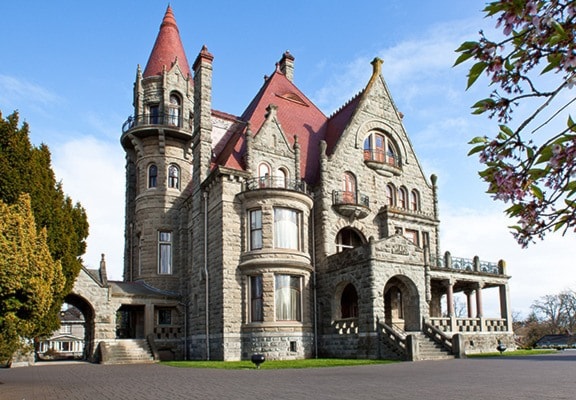(Part 1)
Those who think that the castle has always been there simply don’t know how close it came to being lost.
It’s one of Victoria’s greatest, best-known landmarks, second only to the Parliament Buildings. But, for years, Craigdarroch Castle was a white elephant, unwanted and uncared for, even threatened by development.
If it hadn’t been for native son and historian/journalist James K. Nesbitt it probably would have come down for a modern high-rise.
Briefly: According to legend, coal baron Robert Dunsmuir built the turreted monolith to fulfill a promise he’d made to his wife Joan. That if she accompanied him to the New World he’d make his fortune and build her a fairytale castle. Promise or no, that’s what he did.
Ironically, he didn’t live to see it finished in 1889 but she spent the last years of her life in it as a semi-recluse. Upon her death the 28-acre property passed, in equal shares, to her five daughters who put the property up for sale and it was later subdivided; what was left of the estate, the castle on an acre, passed into the hands of the Bank of Montreal through foreclosure in 1921. But no one knew what to do with the magnificent rockpile and it sat, unoccupied and unattended, until the BMO transferred the deed to the Victoria School Board in 1929.
Almost 40 years passed before James K. Nesbitt entered the story. As with most stories about British Columbia heritage sites, he’d have to endure years of frustrating opposition before he was able to drag civic stakeholders by their noses to approve Craigdarroch’s preservation. Now everyone, blissfully unaware of its close call with ruin, just accepts that the castle has always been there.
For years Nesbitt was the legislative reporter for the Vancouver Sun. On the side, he wrote a weekly feature on old homes and families in the Colonist’s weekend magazine. So it came as no surprise to anyone when, as president of the Craigdarroch Castle Society, he rose to its defence.
In March 1966, the Greater Victoria School Board, the legal tenants, were talking of moving. What was to become of the castle? Nesbitt suggested that Victoria share stewardship with adjoining municipalities and turn it into a museum. But there was the problem of ownership. Victoria thought the GVSB held title but that body’s solicitors thought that their predecessor, the Victoria School Board, had let the property revert to the city upon the GVSB’s formation.
“This is important, but the vital thing is to see that this building is not left unoccupied when the school board departs. I shudder to think what could happen to it in a short time,” said Nesbitt.
Although the city thought that the GVSB were the real owners, it agreed that the building shouldn’t be left unoccupied.
Not everyone thought the castle to be an asset. UVic historian Dr. Sydney W. Jackman termed it “the greatest white elephant in Victoria”. Craigdarroch Castle, he said, “is Balmoral Castle blown across the Atlantic. Very big, very prominent, very uninteresting.”
Responded the Colonist in an editorial: “...As a work of the building art it may not be everyone’s cup of tea, but it is unique nevertheless to Victoria and to the west coast itself... It could well become...a museum of decided value to the community.” In short, Craigdarroch was a feature of the Victoria skyline “not carelessly to be let go”.
City council, still convinced that the school board owned the castle, offered to buy it for “a nominal sum” upon the GVSB’s departure. For their part, the Castle Society, which had convinced itself that the establishment of a museum would follow, collected $7,500 to install floodlights. In the meantime, renovation work undertaken to make the castle a temporary teachers’ resource centre uncovered some of the Dunsmuirs’ original ornamentation that had long been hidden beneath paint and grime.
Everything came to a halt when the school board, short of office space in its new quarters on the Victoria College Lansdowne campus, decided to extend usage of the castle for another five years.
But Craigdarroch’s prominence on the Victoria skyline had already made it an attraction to tourists. The school board, bowing to their increasing visits, went so far as to place a visitors’ book in the lobby. By Labour Day 1967, some 4,000 visitors had signed in, some of them leaving critical comments, such as: “It’s a shame to see this place go to pot.” Another Colonist editorial was equally blunt: “...It is time some official thought [is] given to the maintenance of the castle in the manner that should mark all historic landmarks in the Victoria area. Lip service pays no dividends.”
(To be continued)
